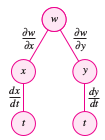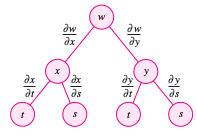Calculus III 13.05 Chain Rules for Functions with Several Variables
| Previous | Calculus III 13.04 Differentials |
| Next | Calculus III 13.06 Directional Derivatives and Gradients |
Contents
- 1 13.05 Chain Rules for Functions with Several Variables
- 2 Internal Links
13.05 Chain Rules for Functions with Several Variables
- Use the Chain Rules for functions with several variables.
- Find partial derivatives implicitly.
Chain Rules for Functions with Several Variables
|
|
The Chain Rule can be extended to functions with two or more variables in two cases. The first case is \(w\) as a function for \(x\) and \(y\), where \(x\) and \(y\) are functions with a single independent variable \(t\), as shown in Theorem 13.5.1. Theorem 13.5.1 Chain Rule: One Independent VariableLet \(w=f(x,y)\), where \(f\) is a differentiable function for \(x\) and \(y\). If \(x=g(t)\) and \(y=h(t)\), where \(g\) and \(h\) are differentiable functions for \(t\), then \(w\) is a differentiable function for \(t\), and
The Chain Rule is shown in Figure 13.5.1 This can be extended to multiple variables. For example, if each \(x_{i}\) is a differentiable function for a single variable \(t\), then for
produces
|
Example 13.5.1 Chain Rule with One Independent Variable
Let \(w = x^{2}y - y^{2}\), where \(x = \sin t\) and \(y=e^{t}\). Find \(dw/dt\) where \(t=0\).
Solution Applying Theorem 13.5.1 produces
| $$\frac{dw}{dt}$$ | $$ = \frac{\partial w}{\partial x}\frac{dx}{dt} + \frac{\partial w}{\partial y}\frac{dy}{dt}$$ |
| \(= 2 xy(\cos t) + (x^{2}-2y)e^{t} \) | |
| \(= 2 (\sin t)(e^{t})( \cos t) + ( \sin^{2} t - 2e^{t})e^{t} \) | |
| \( = 2e^{t} \sin t \cos t + e^{t} \sin^{2} t -2 e^{t}\). |
- $$ \frac{dw}{dt}=-2 \: \text{ when } t=0 $$
Using single variable techniques to find \(dw/dt\) by first writing \(w\) as a function for \(t\),
| \(w\) | \(= x^{2}y - y^{2} \) |
| \(= (\sin t)^{2}(e^{t})-(e^{t})^{2}\) | |
| \(=(e^{t}) \sin^{2} t - e^{2t} \) |
and then differentiating as usual.
- $$ \frac{dw}{dt} = 2e^{2t} \sin t \cos t + e^{t} \sin^{2} t - 2e^{2t} $$
Example 13.5.2 Applying the Chain Rule to Related Rates
|
|
Two objects are traveling in elliptical paths given by the following parametric equations.
At what rate is the distance between the two objects changing when \(t= \pi\)?
as shown in Figure 13.5.2.
and
When \(t=\pi\), the partial derivatives for \(s\) are
When \(t=\pi\), the derivatives for \(x_{1}\), \(y_{1}\), \(x_{2}\), and \(y_{2}\) are
Applying the Chain Rule produces the change rate
|
In Example 13.5.2, note that \(s\) is the function with four intermediate variables, \(x_{1}\), \(y_{1}\), \(x_{2}\), and \(y_{2}\), each is a function with a single variable \(t\). Another composite function type is one where the intermediate variables are themselves functions with more than one variable. For instance, for \(w=f(x,y)\), where \(x=g(s,t)\) and \(y=h(s,t)\), it follows that \(w\) is a function for \(s\) and \(t\). The partial derivatives for \(w\) are considered with respect to \(s\) and \(t\). One way to find these partial derivatives is to write \(w\) as a function for \(s\) and \(t\) explicitly by substituting the equations \(x=g(s,t)\) and \(y=h(s,t)\) into the equation \(w=f(x,y)\). Then the partial derivatives are found in the usual way, as demonstrated in Example 13.5.3.
Example 13.5.3 Finding Partial Derivatives by Substitution
Find \(\partial w/ \partial s\) and \(\partial w/ \partial t\) for \(w=2xy\), where \(x=s^{2}+t^{2}\) and \(y=s/t\).
Solution Begin by substituting \(x=s^{2}+t^{2}\) and \(y=s/t\) into the equation \(w=2xy\) to obtain
- $$ w=2xy = 2(s^{2}+t^{2}) \left( \frac{s}{t}\right) = 2 \left( \frac{s^{2}}{t} + st \right).$$
To find \(\partial w/ \partial s\), hold \(t\) constant and differentiate with respect to \(s\).
| $$ \frac{\partial w}{ \partial s} $$ | $$= 2 \left( \frac{3s^{2}}{t} + t \right) $$ |
| $$= \frac{6s^{2}+2t^{2}}{t}$$ |
To find \(\partial w/ \partial t\), hold \(s\) constant and differentiate with respect to \(t\) to obtain
| $$ \frac{\partial w}{ \partial t} $$ | $$= 2 \left( - \frac{s^{2}}{t^{2}} + s \right) $$ |
| $$= 2 \left( \frac{-s^{2} + st^{2}}{t^{2}} \right) $$ | |
| $$= \frac{-2st^{2} + 2s^{3}}{t^{2}}.$$ |
Theorem 13.5.2 Chain Rule: Two Independent Variables
|
|
Let \(w=f(x,y)\), where \(f\) is a differentiable function for \(x\) and \(y\). If \(x=f(s,t)\) and \(y=h(s,t)\) such that the first partials \(\partial x/ \partial s\), \(\partial x/ \partial t\), \(\partial y/ \partial s\), and \(\partial y/ \partial t\) all exist, the \(\partial w/ \partial s\) and \(\partial w/ \partial t\) exist and are given by
and
as shown in Figure 13.5.3. This extends to functions with multiple variables. For example, if \(w\) is a differentiable function with \(n\) variables.
where each \(x_{1}\) is a differentiable function for the \(m\) variables
then for
produces the following
|
Example 13.5.4 The Chain Rule with Two Independent Variables
Use the Chain Rule to find \(\partial w/ \partial s\) and \(\partial x/ \partial t\) for
- \( w=2xy \)
where \(x = s^{2}+t^{2}\) and \( y = s/t\).
Solution Note that these same partials were found in Example 13.5.3. Using Theorem 13.5.2, hold \(t\) constant and differentiate with respect to \(s\) to obtain
| $$ \frac{\partial w}{ \partial s} $$ | $$ = \frac{\partial w}{ \partial x} \frac{\partial x}{ \partial s} + \frac{\partial w}{ \partial y}\frac{\partial y}{ \partial s} $$ | |
| $$= 2y(2s)+ 2x \left( \frac{1}{t} \right) $$ | ||
| $$ = 2 \left(\color{red}{ \frac{2}{t}} \right)(2s) + 2 (\color{red}{ s^{2}+t^{2} }) \left( \frac{1}{t} \right) \:\:\:\: $$ | Substitute \(\frac{2}{t}\) for \(y\) and \(s^{2}+t^{2}\) for \(x\). | |
| $$= \frac{4s^{2}}{t} + \frac{2s^{2}+2t^{2}}{t} $$ | ||
| $$ = \frac{6s^{2}+2t^{2}}{t}. $$ |
Holding \(s\) constant gives
| $$ \frac{\partial w}{ \partial t} $$ | $$ = \frac{\partial w}{ \partial x} \frac{\partial x}{ \partial t} + \frac{\partial w}{ \partial y}\frac{\partial y}{ \partial t} $$ | |
| $$= 2y(2t)+ 2x \left( \frac{-s}{t^{2}} \right) $$ | ||
| $$ = 2 \left(\color{red}{ \frac{2}{t}} \right)(2t) + 2 (\color{red}{ s^{2}+t^{2} }) \left( \frac{-s}{t^{2}} \right) \:\:\:\: $$ | Substitute \(\frac{2}{t}\) for \(y\) and \(s^{2}+t^{2}\) for \(x\). | |
| $$= 4s - \frac{2s^{3}+2st^{2}}{t^{2}}$$ | ||
| $$ = \frac{4st^{2} - 2s^{3} -2st^{2}}{t^{2}}. $$ | ||
| $$ = \frac{2st^{2} - 2s^{3}}{t^{2}}. $$ |
Example 13.5.5 The Chain Rule with Three Independent Variables
Find \(\partial w/ \partial s\) and \(\partial w/ \partial t\) when\(s=1\) and \(t=2 \pi\) for
- \( w =xy + yz + xz \)
where \(x=s \cos t\), \(y=s \sin t\), and \(z=t\).
Solution Applying Theorem 13.5.2 produces
| $$ \frac{\partial w}{ \partial s} $$ | $$= \frac{\partial w}{ \partial x} \frac{\partial x}{ \partial s} + \frac{\partial w}{ \partial y}\frac{\partial y}{ \partial s} + \frac{\partial w}{ \partial z}\frac{\partial z}{ \partial s}$$ |
| \(= (y+z)(\cos t) + (x+z)(\sin t) + (y+x)(0)\) | |
| \(= (y+z)(\cos t) + (x+z)(\sin t) \) |
When \(s=1\) and \(t=2\pi\), \(x=1\), \(y=0\), and \(z=2\). Therefore,
- $$ \frac{\partial w}{ \partial s} = (0+ 2\pi)(1)+(1 + 2 \pi)(0) = 2 \pi$$
Furthermore,
| $$ \frac{\partial w}{ \partial t} $$ | $$= \frac{\partial w}{ \partial x} \frac{\partial x}{ \partial t} + \frac{\partial w}{ \partial y}\frac{\partial y}{ \partial t} + \frac{\partial w}{ \partial z}\frac{\partial z}{ \partial t}$$ |
| \(= (y+z)(-s \sin t) + (x+z)(s \cos t) + (y+x)(1)\) |
and for \(s=1\) and \(t=2 \pi\), it follows that
| $$ \frac{\partial w}{ \partial t} $$ | \(= (0+2 \pi)(0) + (1+2 \pi)(1) + (0+1)(1)\) |
| \(= 2 + 2 \pi\) |
Implicit Partial Differentiation
Let \(x\) and \(y\) be related by the equation \(F(x,y)=0\), where \(y=f(x)\) is a differentiable function for \(x\). The Chain Rule can be applied to find the derivatives. Consider the function
- \(w=F(x,y) = F(x,f(x))\).
Applying Theorem 13.5.2 yields
- $$ \frac{dw}{dx} = F_{x}(x,y)\frac{dx}{dx}+ F_{y}(x,y)\frac{dy}{dx}. $$
Because \(w=F(x,y) = 0 \) for all \(x\) in \(f\)'s domain it follows that
- $$ \frac{dw}{dx} = 0 $$
and produces
- $$ F_{x}(x,y)\frac{dx}{dx}+ F_{y}(x,y)\frac{dy}{dx} = 0. $$
If \(F_{x}(x,y) \ne 0 \), use the fact that \(dx/dx = 1\) to conclude that
- $$ \frac{dy}{dx} = - \frac{F_{x}(x,y)}{F_{y}(x,y)}. $$
A similar procedure can find the partial derivatives for functions with several variables that are defined implicitly.
Theorem 13.5.3 Chain Rule: Implicit Differentiation
If the equation \(F(x,y)=0\) defines \(y\) implicitly as a differentiable function for \(x\), then
- $$ \frac{dy}{dx} = - \frac{F_{x}(x,y)}{F_{y}(x,y)}, \: F_{y}(x,y) \ne 0.$$
If the equation \(F(x,y,z)=0\) defines \(z\) implicitly as a differentiable function for \(x\) and \(y\), then
- $$ \frac{dz}{dx} = - \frac{F_{x}(x,y,z)}{F_{z}(x,y,z)} \text{ and } \frac{dz}{dy} = - \frac{F_{y}(x,y,z)}{F_{z}(x,y,z)}, \: F_{z}(x,y,z) \ne 0.$$
This theorem can be extended to functions defined implicitly with any variable count.
Example 13.5.6 Finding a Derivative Implicitly with Two Variables
Find \(dy/dx\) for
- \(y^{3}+y^{2}-5y-x^{2}+4=0.\)
Solution Begin by letting
- \(F(x,y) = y^{3}+y^{2}-5y-x^{2}+4.\)
Then
- \( F_{x}(x,y)= -2x \) and \( F_{y}(x,y)= 3y^{2}+2y-5. \)
Applying Theorem 13.5.3 produces
- $$ \frac{dy}{dx} = - \frac{F_{x}(x,y)}{F_{y}(x,y)} = \frac{ - (\color{red}{-2x})}{\color{red}{3y^{2}+2y-5}} = \frac{-2x}{3y^{2}+2y-5}. $$
Example 13.5.7 Finding a Derivative Implicitly with Three Variables
Find \(dz/dx\) and \(dz/dy\) for
- \( 3x^{2}z - x^{2}y^{2} + 2z^{3} + 3yz -5 = 0. \)
Solution Begin by letting
- \( F(x,y,z) = 3x^{2}z - x^{2}y^{2} + 2z^{3} + 3yz -5. \)
Then
- \( F_{x}(x,y,z)= 6xz-2xy^{2} \)
- \( F_{y}(x,y,z)= -2x^{2}y+3z \)
- \( F_{z}(x,y,z)= 3x^{2} + 6z^{2}+3y \)
Applying Theorem 13.5.3 produces
- $$ \frac{dz}{dx} = - \frac{F_{x}(x,y,z)}{F_{z}(x,y,z)} = \frac{2xy^{2}-6xz}{3x^{2}+6z^{2}+3y} $$
and
- $$ \frac{dz}{dy} = - \frac{F_{y}(x,y,z)}{F_{z}(x,y,z)} = \frac{2x^{2}y-3z}{3x^{2}+6z^{2}+3y}.$$
Internal Links
Parent Article: Calculus III 13 Functions with Several Variables


